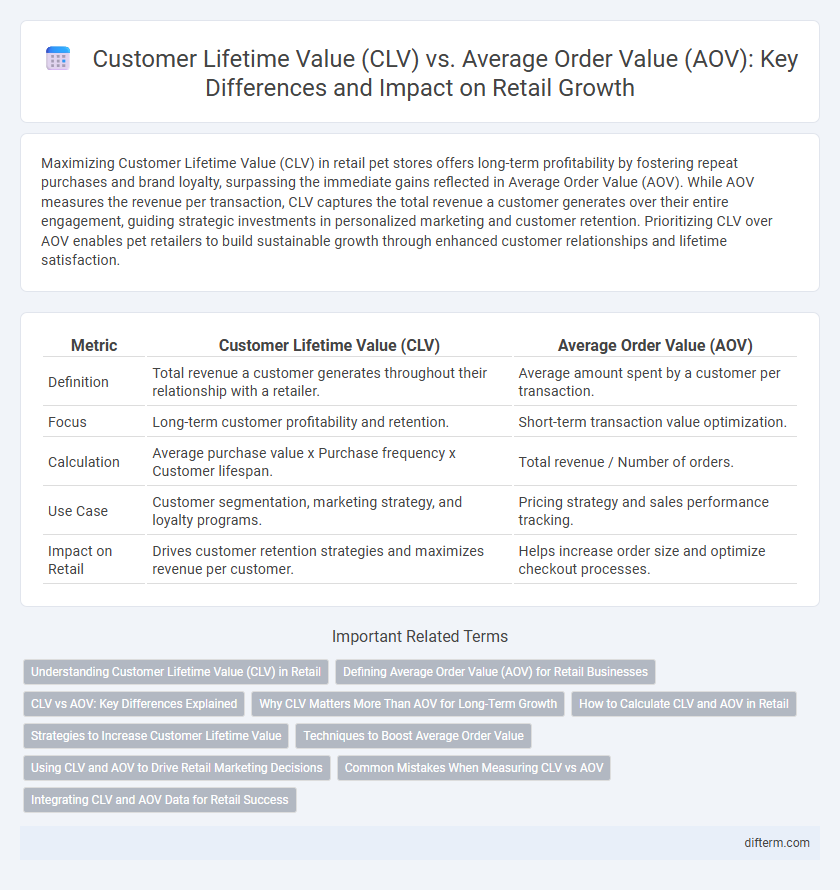Maximizing Customer Lifetime Value (CLV) in retail pet stores offers long-term profitability by fostering repeat purchases and brand loyalty, surpassing the immediate gains reflected in Average Order Value (AOV). While AOV measures the revenue per transaction, CLV captures the total revenue a customer generates over their entire engagement, guiding strategic investments in personalized marketing and customer retention. Prioritizing CLV over AOV enables pet retailers to build sustainable growth through enhanced customer relationships and lifetime satisfaction.
Table of Comparison
| Metric | Customer Lifetime Value (CLV) | Average Order Value (AOV) |
|---|---|---|
| Definition | Total revenue a customer generates throughout their relationship with a retailer. | Average amount spent by a customer per transaction. |
| Focus | Long-term customer profitability and retention. | Short-term transaction value optimization. |
| Calculation | Average purchase value x Purchase frequency x Customer lifespan. | Total revenue / Number of orders. |
| Use Case | Customer segmentation, marketing strategy, and loyalty programs. | Pricing strategy and sales performance tracking. |
| Impact on Retail | Drives customer retention strategies and maximizes revenue per customer. | Helps increase order size and optimize checkout processes. |
Understanding Customer Lifetime Value (CLV) in Retail
Customer Lifetime Value (CLV) in retail quantifies the total revenue a business expects from a single customer throughout their entire relationship. CLV provides deeper insights into customer loyalty and retention, surpassing the immediate profitability measured by Average Order Value (AOV). Optimizing CLV enables retailers to devise targeted marketing strategies, enhance customer satisfaction, and increase long-term profitability.
Defining Average Order Value (AOV) for Retail Businesses
Average Order Value (AOV) in retail represents the average amount customers spend per transaction, calculated by dividing total revenue by the number of orders during a specific period. It serves as a critical indicator for understanding purchasing behavior and optimizing pricing strategies, promotions, and product bundling. Tracking AOV enables retailers to improve marketing efforts and increase revenue by encouraging larger purchases through targeted upselling and cross-selling techniques.
CLV vs AOV: Key Differences Explained
Customer Lifetime Value (CLV) measures the total revenue a customer generates throughout their relationship with a retailer, while Average Order Value (AOV) calculates the average amount spent per transaction. CLV focuses on long-term profitability by predicting future purchases, whereas AOV emphasizes short-term sales performance in individual orders. Retailers use CLV to optimize customer retention strategies and AOV to boost immediate sales through pricing and promotions.
Why CLV Matters More Than AOV for Long-Term Growth
Customer Lifetime Value (CLV) surpasses Average Order Value (AOV) as a critical metric in retail because it measures the total revenue a business can expect from a single customer over time, emphasizing sustainable growth rather than one-time sales. Retailers focusing on CLV optimize marketing strategies, improve customer retention, and increase profitability by nurturing long-lasting relationships. Investing in CLV-driven tactics ensures consistent revenue streams, reducing dependency on acquiring new customers and maximizing lifetime profitability.
How to Calculate CLV and AOV in Retail
Customer Lifetime Value (CLV) is calculated by multiplying the average purchase value, purchase frequency, and customer lifespan, providing a comprehensive measure of a customer's total revenue potential. Average Order Value (AOV) is determined by dividing total revenue by the number of orders during a specific period to gauge typical spending per transaction. Retailers utilize CLV and AOV to optimize marketing strategies, prioritize customer retention, and enhance revenue forecasting.
Strategies to Increase Customer Lifetime Value
Strategies to increase Customer Lifetime Value (CLV) in retail include personalized marketing campaigns that leverage purchase history and customer preferences to drive repeat purchases. Implementing loyalty programs and subscription services enhances customer retention and encourages higher spending over time. Investing in exceptional customer service and seamless omnichannel experiences fosters long-term relationships, significantly boosting CLV beyond the scope of Average Order Value (AOV).
Techniques to Boost Average Order Value
Techniques to boost Average Order Value (AOV) in retail include implementing upselling strategies and personalized product recommendations to encourage customers to purchase higher-value items or additional products. Bundling complementary products and offering volume discounts can also increase the transaction size effectively. Leveraging data analytics to identify customer preferences and optimize pricing further enhances AOV by delivering tailored shopping experiences.
Using CLV and AOV to Drive Retail Marketing Decisions
Customer Lifetime Value (CLV) offers a comprehensive measure of a customer's long-term revenue potential, while Average Order Value (AOV) focuses on the immediate purchase size. Retailers leveraging CLV can optimize marketing spend by targeting high-value customers and fostering loyalty, whereas AOV insights help refine pricing strategies and promotional offers to boost transaction sizes. Integrating CLV and AOV data enables more precise segmentation and personalized marketing campaigns, enhancing customer retention and maximizing overall profitability.
Common Mistakes When Measuring CLV vs AOV
Confusing Customer Lifetime Value (CLV) with Average Order Value (AOV) often leads retailers to underestimate the long-term profitability of customers by focusing solely on single-transaction metrics. Mistakes such as ignoring purchase frequency and retention rates skew CLV calculations, while overemphasizing AOV can result in misallocated marketing budgets targeting high-value but infrequent buyers. Proper segmentation and integration of customer behavior data are essential to avoid these pitfalls and accurately assess true customer value.
Integrating CLV and AOV Data for Retail Success
Integrating Customer Lifetime Value (CLV) and Average Order Value (AOV) data enables retailers to develop targeted marketing strategies and optimize customer acquisition costs. Analyzing combined CLV and AOV metrics helps identify high-value customer segments and tailor personalized promotions that increase retention and average purchase size. Leveraging this integrated data supports data-driven inventory management and enhances long-term revenue growth in competitive retail markets.
Customer Lifetime Value (CLV) vs Average Order Value (AOV) Infographic

 difterm.com
difterm.com